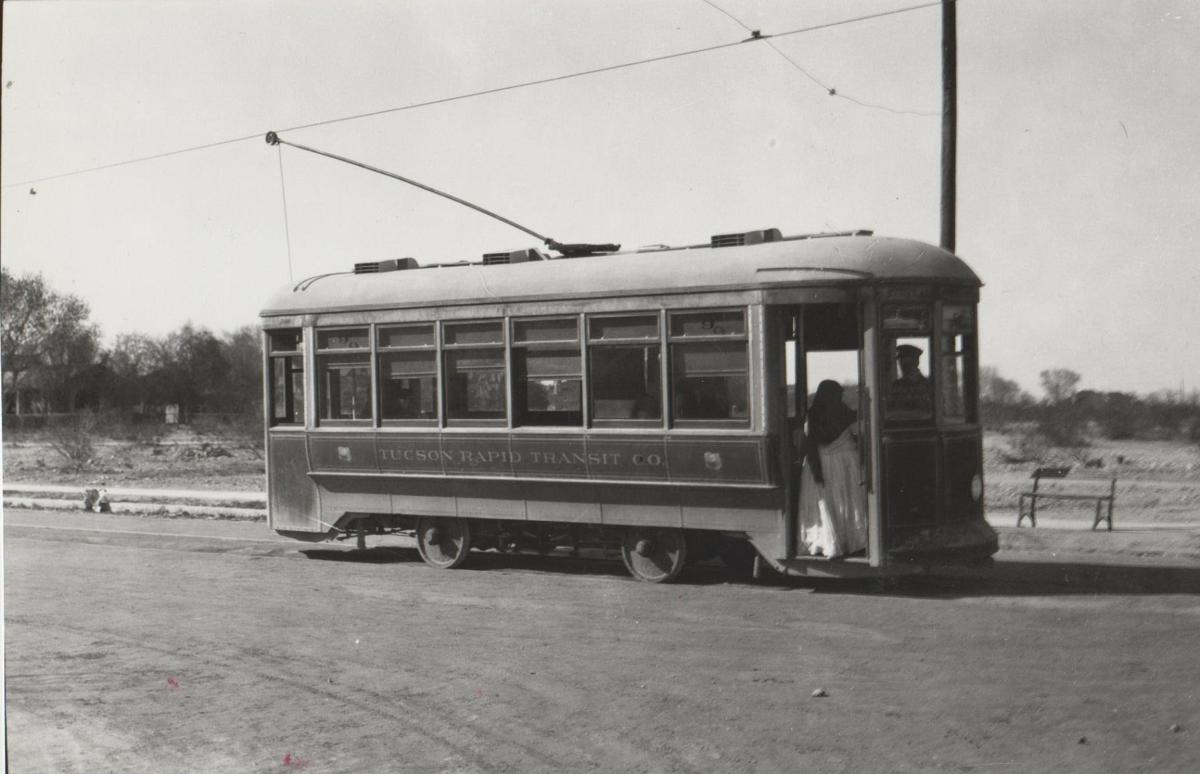-----
 |
| (Jeff Wallace) |
1879 brought with it many important events in America: The Transcontinental Railroad had its completion date legally defined, Thomas Edison first demonstrated his incandescent bulbs at Menlo Park, New York's Gilmore Gardens was renamed Madison Square Garden, and the town of Deadwood, South Dakota, burned down with over $3 million in damages. But amongst all the events, a smaller revolution came to the town of Tucson, Arizona: its first trolley line.
 |
| Horsecar No. 6, sometime after 1900 (University of Arizona) |
Entrepnuer Bill Morgan established a "herdic" service in Tucson two years after the town was incorportated. At the start of the decade, the town gained a connection to the West Coast via the San Diego-Tucson telegraph in 1873, but now it had a public transport service. A "herdic" is another word for a "horsecar", being a closed-body carraige on rails. It ran from Downtown to the Nine Mile Water Hole along the Canada de Oro wash. The herdic would be rerouted once in its two decade of operation: when the Southern Pacific arrived in Tucson, the tracks were moved to add a stop at the new train station.
 |
| A headline in the Arizona Daily Star announcing the rebuilding of an original Elysian Grove building in 1924 (Arizona Daily Star) |
In 1898, the Tucson Street Railway (TSR) was established as a mule-drawn street railway. As the town was originally a stagecoach station, it never had any viable commodities to allow for electric streetcar service in a time when almost every electric railway in America was being established. This was also well before any main street in Tucson was paved, which meant pedestrians would often be bogged down in mud or trip over the raised steel rails. Nevertheless, the company managed to ring in the new century with an expansion north and south and even establish their own trolley park called "Elysian Grove."
 |
| "The last of the Mule Trolley - Tucson 1906" (University of Arizona) |
By 1904, the TSR had more than eight miles of horsecar track, seven horsecars, and 34 head of livestock in both mules and horses. Unfortunately, the large amount of animals also meant frequent, if not inherent, scheduling issues as streetcar frequencies would always depend on how the animals were feeling that day. The city eventually had enough and, in 1906, forced the TSR to modernise with electric streetcars on heavier rail and running on overhead wire. The company was renamed the Tucson Rapid Transit Company (TRT).
The streetcar proved to be a welcome addition to the town, where car travel was otherwise foreign. In 1915, Tucson had gained a significant chunk of paved road and yet the TRT proved so successful the roster swelled to nine streetcars. Ten years on, three more streetcars were delivered to bring the grand total to twelve, and buses were brought in to supplement service with a consistent 15-minute service interval. Despite the size of the system, it never suffered any heavy line closures or other operational malady that plagued street railways three times its size around the US and continued to trundle along without fanfare until 1930.
 |
| One of the TRT's tiny not-Birneys collecting a passenger. Adorable, isn't it? (Arizona Daily Star) |
That year, the Tucson City Council decided to discontinue streetcar service effective at the end of the year. On December 31, 1930, the last streetcar would roll along Tucson's streets before being shuttered and the tracks were paved over in favor of bus service. As quietly as it began, the Tucson Rapid Transit Company went as quietly for the next fifty years... until 1983, but that's a story for another time. (Shoutout to CGP Grey)
-----
Thank you for starting this new month of Trolleyposting with me, your motorman writer, and Nakkune, my editor. If you would like to financially support this series, please check out my Redbubble store where you can purchase merch made by me and keep this series going. As always, ride safe!

No comments:
Post a Comment